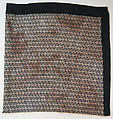Ensemble
Designer Miguel Adrover
(c) Fendi Italian
Not on view
This design from Miguel Androver's second collection was described by Cathy Horyn of the New York Times as "a simple but respectable Sunday-going-to-church outfit out of a Willa Cather story." Its faded, dusty colors and worn surface made Horyn's reference especially apt. However, the ensemble took on other evocative connotations-either macabre or poignant, depending on one's point of view-when Adrover noted that the fabric was taken from the discarded mattress of the late Quentin Crisp. The designer's salvaging of this piece of urban detritus, with its forlorn history of wear and rusty stains, and transforming it into a tailored coat was less recycling than poetic reinvention. Like Martin Margiela, Adrover incorporates the Dadaist strategy of unexpected recontextualizations. In this instance, a classically tailored coat is invested with the resonance of a very public person's intensely personal history.
"At the time the homeless had no ticking, Giuliani kicked it out of the shelters. Like England kicked out Quentin Crisp for the way he was; but I ¤ NY gave him a mattress. A mattress like the one I am now consulting (over) and writing from, remembering . . . a f[---]ing freezing night on Third Street between First and Second Avenue covered by a thin layer of snow. He was lying down on the sidewalk, the bodiless mattress. But with a lot of knowledge, the knowledge of sharing someone's dream of freedom, something priceless, like the ticking fabric that I was lucky to rescue from conventionalism, trying to bring some light to the memory of my once neighbor."
-Miguel Adrover
Due to rights restrictions, this image cannot be enlarged, viewed at full screen, or downloaded.
This artwork is meant to be viewed from right to left. Scroll left to view more.







